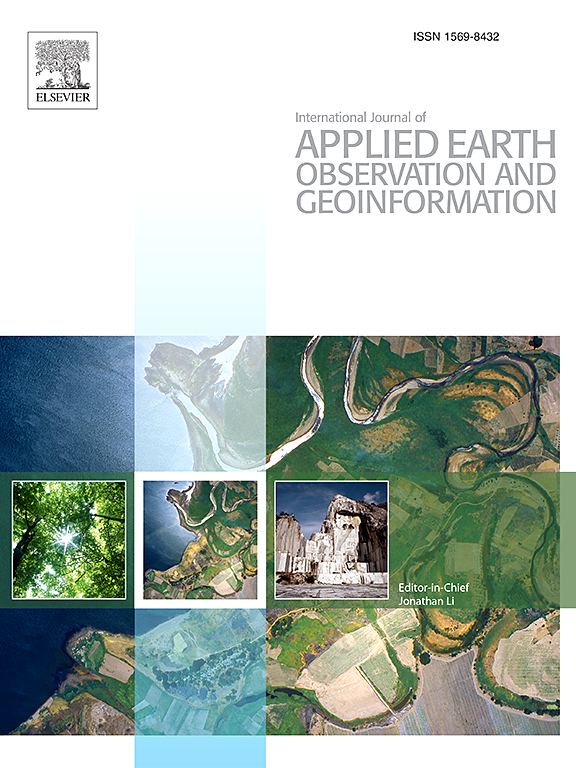楚科奇海海冰和云的中国紫外-可见-红外观测辨析
IF 7.6
Q1 REMOTE SENSING
International journal of applied earth observation and geoinformation : ITC journal
Pub Date : 2025-03-28
DOI:10.1016/j.jag.2025.104508
引用次数: 0
摘要
北极海冰的分布是气候变化的重要直接指标,而星载光学遥感以其高时空分辨率和广阔的覆盖范围成为海冰监测的主要技术之一。然而,这一过程经常受到厚厚的云层的阻碍,云层与海冰有着相似的视觉和光谱特征。为了解决这些问题,本研究首次利用中国海洋- 1c /D (hyc - 1c /D)卫星的紫外-可见-红外观测数据,并利用机载紫外成像仪(UVI)的紫外数据对楚科奇海的海冰和云进行了研究,提出了一种区分海冰和不同云类型(卷云和积云)的新方法框架。光谱性质由大气顶(TOA)在紫外、可见光和近红外(VNIR)波段的反射率(ρTOA)表征。这表明355nm紫外波段对海冰和云的存在具有最佳的灵敏度,其中由高空冰晶组成的卷云具有极高的紫外反射率。然后确定一个混合阈值来分离海冰和云像素。与MODIS MOD29海冰产品遮挡亮度温度(BT)差异的云像元相比,该算法可以有效减少极地地区地表温度逆温导致的误分类。冰/云识别结果已进一步应用于海冰浓度(SIC)估计,并且在北极通道中对这种基于紫外线的冰/云检测方法进行了广泛的试验,证明了其潜在的适用性。本文章由计算机程序翻译,如有差异,请以英文原文为准。
Discrimination between sea ice and clouds over the Chukchi Sea via China’s ultraviolet–visible-infrared observations
The distribution of Arctic sea ice is an important direct indicator of climate change, and spaceborne optical remote sensing represents one primary technique for sea ice monitoring due to its high spatiotemporal resolution and wide swath coverage. However, this process is often impeded by heavy cloud cover, which shares similar visual and spectral features with sea ice. To address these limitations, this study proposes a novel methodological framework for discriminating between sea ice and different cloud types (cirrus and cumulus) via the ultraviolet–visible-infrared observations from China’s Haiyang-1C/D (HY-1C/D) satellites, and the ultraviolet (UV) data from the onboard Ultraviolet Imager (UVI) are used to study sea ice and clouds over the Chukchi Sea for the first time. The spectral properties are characterized by the top-of-atmosphere (TOA) reflectance (ρTOA) in both UV and visible and near-infrared (VNIR) wavelengths. This indicates that the 355 nm UV band has the optimal sensitivity to the presence of sea ice and clouds, with cirrus clouds composed of high-altitude ice crystals exhibiting extremely high UV reflectivity. A hybrid threshold is subsequently determined to separate sea ice and cloud pixels. In comparison to the MODIS MOD29 sea ice product, which masks cloud pixels with brightness temperature (BT) differences, this algorithm can effectively reduce the misclassification resulting from surface temperature inversions in polar regions. The ice/cloud identification results have been further applied to sea ice concentration (SIC) estimation, and extensive trials of this UV-based ice/cloud detection approach in the Arctic Passages demonstrates its potential applicability.
求助全文
通过发布文献求助,成功后即可免费获取论文全文。
去求助
来源期刊

International journal of applied earth observation and geoinformation : ITC journal
Global and Planetary Change, Management, Monitoring, Policy and Law, Earth-Surface Processes, Computers in Earth Sciences
CiteScore
12.00
自引率
0.00%
发文量
0
审稿时长
77 days
期刊介绍:
The International Journal of Applied Earth Observation and Geoinformation publishes original papers that utilize earth observation data for natural resource and environmental inventory and management. These data primarily originate from remote sensing platforms, including satellites and aircraft, supplemented by surface and subsurface measurements. Addressing natural resources such as forests, agricultural land, soils, and water, as well as environmental concerns like biodiversity, land degradation, and hazards, the journal explores conceptual and data-driven approaches. It covers geoinformation themes like capturing, databasing, visualization, interpretation, data quality, and spatial uncertainty.
 求助内容:
求助内容: 应助结果提醒方式:
应助结果提醒方式:


